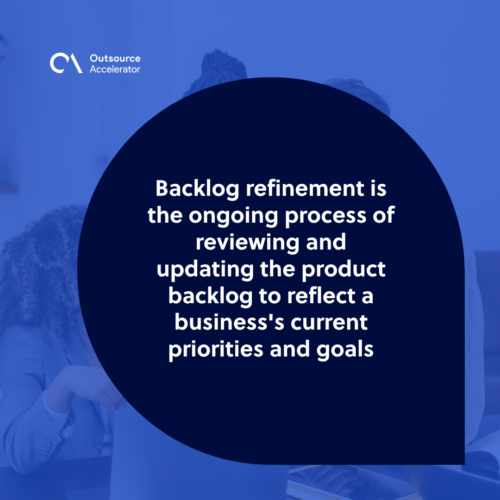Backlog refinement: Optimizing agile workflow

These days, software development uses the popular agile methodology approach. This method emphasizes flexibility, collaboration, and continuous improvement in whatever project an organization is undertaking.
One of the agile methodology’s key components is backlog refinement — a concept that aims to organize and orient a company’s backlogged items with current goals and objectives.
In this post, we will further elaborate on the concept of backlog refinement, its process, and its benefits. We’ll also provide tips for effective execution.
What is backlog refinement?
Backlog refinement is also knowns as backlog grooming or backlog management. It is the ongoing process of reviewing and updating the product backlog to reflect a business’s current priorities and goals.
And what is a product backlog? It’s a prioritized list of features, enhancements, and bug fixes scheduled to be worked on in the future.
In addition, backlog refinement is a collaborative process that involves an entire team, including the product owner, developers, and other stakeholders.

Backlog refinement process
Backlog refinement usually follows a series of steps that ensures effective and agile product backlog management. Common backlog refinement steps include:
Grooming
The team reviews the product backlog and gets rid of any irrelevant and unnecessary items. This step is where larger items are broken down into smaller, more manageable tasks.
Prioritization
The remaining items in the product backlog are then prioritized based on their importance and urgency. The team may use tools and techniques like user story mapping or value-based prioritization to help with this step.
Estimation
After prioritizing items in the product backlog, an estimation is made to measure the effort required to complete each item. This helps the team plan their work and ensure they are not overcommitting.
Establishing acceptance criteria
Lastly, the team defines the acceptance criteria for each product backlog item. This helps guarantee that everyone understands what needs to be done and when it is considered complete.
When do you need backlog refinement?
Backlog refinement is necessary for every project, and it should always be ongoing. However, there are certain situations where it is imperative, such as:
- When a high volume of change requests or new feature requests is being experienced.
- When the team is struggling to meet their sprint goals.
- When the product owner has identified new priorities or goals for the project.
- When the team is experiencing a high level of technical debt or bugs.
Benefits of backlog refinement
Backlog refinement offers several benefits to an organization’s operations and outcomes. Here’s why the backlog refinement process should be continuously implemented:
Stronger team collaboration
It ensures everyone on the team is on the same page about the project goals and priorities. The process makes teams work together harmoniously.
Increased productivity
Regularly reviewing and updating the product backlog verifies the most important and urgent items that should be worked on. Therefore, productivity is increased, and resources are not wasted.
Better decision-making and adaptability
Teams will likely make better and more informed decisions about what to work on next when the product backlog is reviewed, organized, and updated. With the prioritization of items, workers will be able to make the best use of their time and resources.
Improved product quality
Before executing the backlog refinement process, acceptance criteria should be clearly defined and agreed upon. Those involved in the procedure can rest easy knowing they deliver high-quality products that meet customer needs.

Tips for effective backlog refinement
There are plenty of ways to make the most of backlog refinement. Here are a couple of tips to keep in mind:
Schedule regular meetings
We’ve established that backlog refinement should be an ongoing process. With that in mind, it can be helpful to schedule regular meetings to ensure everyone is aware of the current situation and plans.
Get the entire team involved
Backlog refinement involves an entire team. This process is a good way for everyone to have a chance to contribute their ideas and insights.
Keep the backlog manageable
Being practical is important in backlog refinement because a team should be able to work through the product backlog in a reasonable amount of time. This means the product backlog should be a manageable size.
Prioritize based on the value
Using value-based prioritization techniques allows the team to work on the most important and urgent items in the product backlog. As a result, it enhances the team’s overall efficiency and productivity.
Make data-driven decisions
Backlog refinement decisions are boosted by using data and metrics. These elements help the organization make informed decisions rather than proceeding with just assumptions.
Use specialized software
There are plenty of project management tools and software available that can help an organization refine its backlog. Using tools and software facilitates an optimized, agile process that makes it easier for workers to do their tasks.
When it comes to project management, agile methodologies like backlog refinement become crucial as it truly improves a company’s overall operations and outcomes.
Backlog refinement is one of those amazing processes that can be leveraged to optimize agile workflow, especially if an organization needs a way to be more effective and efficient.







 Independent
Independent




